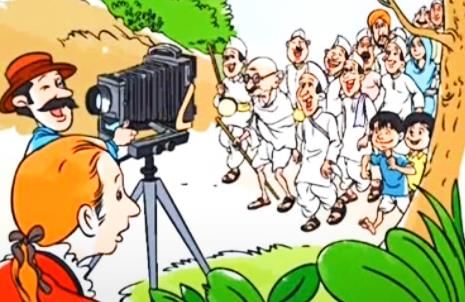Detailed Summary: A Handful of Salt | English Reader New Gems Class 6 PDF Download
| Table of contents |

|
| Key Points |

|
| Detailed Summary |

|
| Theme/ Message |

|
| Difficult Words |

|
Key Points
- The story is about two boys, Dhani and Gokul, who climb a peepal tree to watch a procession led by Mahatma Gandhi, also called Bapu.
- They are excited to see the march to the sea where Bapu plans to make salt, protesting against the British salt tax.
- Dhani is confused about why making salt is important and wishes for a more exciting protest like burning foreign goods.
- Gokul explains that the salt tax is unfair and that Bapu wants to encourage everyone to make salt freely.
- The boys eagerly await the procession and finally spot Bapu, who looks kind and gentle as he walks with a stick.
- As the procession gets closer, more villagers join in, creating a long line of people walking together.
- Dhani and Gokul are so excited that they jump down from the tree to join the march without worrying about anything else.
- They notice British photographers taking pictures of the march, which makes them feel proud.
- The group takes breaks during their long walk, and the village women provide food for everyone.
- They learn that the journey to Dandi is very long, estimated to take three to four weeks.
- Gokul’s father unexpectedly finds them in the march and tells them they have to go home because it is too long for them.
- Before leaving, they take a last look at Bapu, who is resting peacefully under a tree.
Detailed Summary
In a small village in Gujarat, two young boys named Dhani and Gokul are very excited. They have climbed the tallest peepal tree in the village to get a good view of the road. They want to see an important person, a man known as Bapu, who is going to lead a march to the sea. This march is special because Bapu and his followers are going to make salt, which is against the law set by the British government. The boys are eagerly waiting and have brought some food, just in case they have to wait a long time.
Dhani, the more curious of the two, asks Gokul how they will know when Bapu is coming. He wonders if there will be drums, singing, or dancing, like in a play. Gokul laughs and tells him that this is not a show; it is a serious march for freedom. The boys have heard everyone in the village talking about this march for days, and they are excited to see it happen.

Gokul explains to Dhani that Bapu is going to the seaside to make salt because all Indians have to pay a tax on salt. This tax is very unfair, especially for poor farmers. The British government makes the rules, and Bapu wants to protest against this unfair law. He plans to break the law by making salt himself, and he wants everyone in the country to join him in this protest. Dhani thinks Bapu is very clever for doing this, and they both admire him.
As they wait in the tree, they are eager to see the procession. Gokul mentions that Bapu and his followers planned to start early that morning from their home, the Sabarmati Ashram, which is not far away. Dhani becomes more excited and believes they should see Bapu soon.
Suddenly, they see people coming down the road. The procession looks like a moving white river, full of people in white clothes. The boys sit up straight in the tree to get a better look. Leading the group is a thin man dressed in a simple white dhoti and a shawl. He walks with a tall stick, and as he gets closer, Dhani realizes that this is Bapu, Mohandas Karamchand Gandhi. He is known as the Mahatma, which means the "Great Soul."
Bapu looks like a kind grandfather, someone who should be sitting comfortably in the village, but instead, he is leading a march for the freedom of his people. He walks quickly, talking to everyone around him. Sometimes, people run up to him to give him flowers or to touch his feet, showing their respect and love for him. Even though he looks thin and frail, he walks with surprising speed.
As the march goes on, more and more people join in from the sides of the road. Men, women, and children all walk together to make salt. The boys are thrilled and jump down from the tree to join the crowd. They forget about their parents’ worries and the food they have. The excitement of being with Bapu and the crowd is too much for them to resist.
As they walk, they feel like the whole of India is with them. The boys notice some British people taking pictures of the march with strange metal boxes. Gokul is happy to think that his picture might have been taken too. The procession continues, and Bapu keeps on walking and smiling, talking to people he meets along the way.
They walk through different villages, over muddy paths and stony roads. After some time, they stop to rest. The village women bring food for everyone, sharing vegetables and chapatis. Dhani starts to wonder what Bapu is eating because he is walking so much and needs energy to keep going.
The boys listen to a group of men talking about the long journey ahead. One man explains that they have to walk about 385 kilometers to reach Dandi, where they will make salt. He says it might take three to four weeks if they only walk in the mornings and evenings. The boys realize how long this journey is and how important it is for Bapu to unite the country. Gokul admires Bapu even more, thinking about how this march will get everyone talking about their fight for freedom.

Just then, they see a tall, thin man coming towards them. It turns out to be Gokul's father, who has also joined the march without them knowing. Both boys are surprised and quickly ask him what he is doing there. Gokul's father shakes his head, saying he should have known his son would want to be part of this march. However, he tells them it is time to go home. He explains that the march is too long for small boys like them.
Gokul asks his father if he will continue with the march, but his father says he is going back with others from their village. Bapu wants everyone to stay safe and not leave their work behind. Before they leave, Dhani asks if they can see Bapu one last time. Gokul's father agrees, and they approach Bapu, who is now resting on a charpoy under a tree, fast asleep.
The boys take one last look at Bapu, admiring him for his bravery and kindness, before they begin the long walk back home. They feel proud to have seen Bapu and to have been part of this important moment in history, even if just for a little while.
This chapter tells us about the courage and determination of Bapu and his followers as they march for freedom. It shows how even young boys like Dhani and Gokul can feel inspired to be part of something bigger than themselves. The march to make salt becomes a symbol of the fight against unfair laws and the struggle for independence in India. Through the eyes of the boys, we see the importance of this moment and how it brings people together in a common cause.
Theme/ Message
- The main theme of the story is the importance of peaceful protest. Bapu leads a march to make salt, which symbolizes defiance against unfair laws.
- It shows how ordinary people can come together to support a cause and fight for their rights.
- The story emphasizes the spirit of unity and community, as many villagers join the march together, highlighting the collective strength of the people.
- Another theme is the innocence of childhood. Dhani and Gokul represent the curiosity and eagerness of children to participate in important events.
- The message of the story is that a single act of bravery can inspire many others. Bapu’s determination to make salt encourages the entire nation to stand up against injustice.
- The story teaches us that it is important to stand up for what is right, even if it means facing challenges. Bapu’s peaceful approach shows that change can be achieved without violence.
- It also reminds us that children can be part of significant movements and that their enthusiasm can contribute to larger causes.
Difficult Words
- Procession: A group of people walking together in a formal or organized way.
- Defy: To openly resist or refuse to obey something.
- Tax: Money that people have to pay to the government for public services.
- Khadi: A type of cloth made from hand-spun yarn, often associated with Indian independence.
- Benign: Kind and gentle; not harmful.
- Grandfatherly: Having qualities that are kind, caring, and wise, like a grandfather.
- Brisk: Quick and energetic; done with speed.
- Frugal: Careful about spending money or using resources; economical.
- Estimation: An approximate calculation or judgement about a number or value.
- Unity: The state of being together as one; harmony among individuals.
- Collective: Done by people acting as a group.
- Journey: The act of traveling from one place to another, often over a long distance.
- Innocence: The quality of being naive or not having experience, often associated with children.
- Symbolize: To represent something else, often an idea or quality.
- Resting: Being in a state of relaxation or sleep, not active.
|
69 videos|283 docs|61 tests
|
FAQs on Detailed Summary: A Handful of Salt - English Reader New Gems Class 6
| 1. What is the main theme of the story "A Handful of Salt"? |  |
| 2. Who are the main characters in "A Handful of Salt"? |  |
| 3. What lesson does the father teach his son in the story? |  |
| 4. How does the story "A Handful of Salt" illustrate the consequences of actions? |  |
| 5. What is the significance of the title "A Handful of Salt"? |  |














